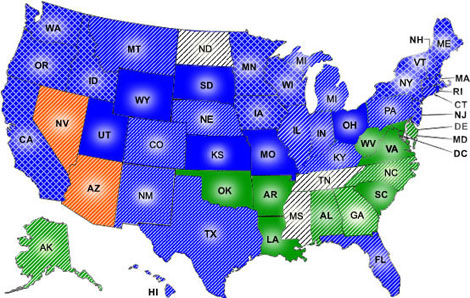Energy-Efficiency Funds and Demand Response Programs
Select a state below to access more detailed information about that state's programs.
Legend
| [Blue] |
These states have public purpose and/or utility energy efficiency programs as well as demand response/load management programs. |
| [Green] |
These states have demand response/load management programs. |
| [Orange] |
These states have public purpose and/or utility energy efficiency programs. |
 |
These states have distributed energy resource options available. |
 |
These states have gas energy efficiency programs. |
| [White] |
These states have no energy management programs. |

Note
The energy management programs are categorized according to the following definitions:
- Energy Efficiency Programs: Can be either 1) public purpose programs which are administered either by utilities, state agencies or other third parties, and are paid for by utility ratepayers, typically through a non-bypassable System Benefits Charge which is instituted as part of restructuring legislation or rules or 2) utility programs administered by the local utility and paid for by utility ratepayers through their bundled rates.
- Demand Response Programs/Load Management: Programs which provide incentives to curtail demand and reduce load during peak periods in response to system reliability or market conditions.


















